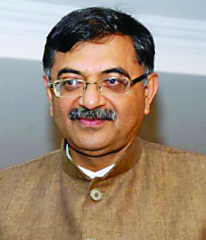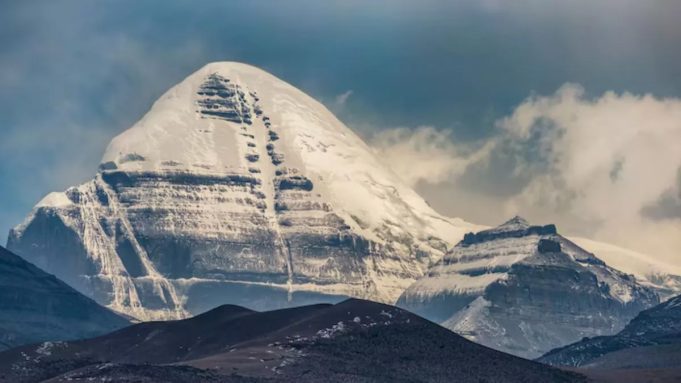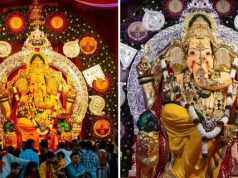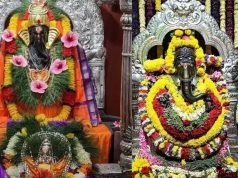For thousands of years, Vedic Sanatan Dharmi, Jain and Buddhist followers have been doing the world’s most ancient and difficult Kailash Mansarovar Yatra. This journey is also mentioned in Mahabharata. The Nirvana place of the first Jain Tirthankar Rishabhdev is here at a place called Ashtapad, which is at the foot of Mount Kailash. The founder of Swaminarayan sect, Neelkanth Varni, came on Kailash Yatra in February 1793. Guru Nanak also went on this Yatra. Gurdwara Patthar Saheb, associated with the journey of Guru Nanak near Leh, is under the supervision of the Indian Army.
There was a time when people going on Kailash Yatra would perform their shraddha-tarpan before leaving because they were not sure that they would return. For this reason, the word ‘Kailashvaasi’ is used in Marathi for a person who has gone to heaven. Before the Chinese invasion of 1962, there were more than 10 routes for Kailash Yatra from India – such as from Leh via Demchok, Shipki La in Himachal, Vasudhara beyond Badrinath, Munsiyari via Milam Glacier route and Dharchula-Lipu Lekh route and from Sikkim via Nathu La.
After the 1962 war, the pilgrimage through Indian routes was stopped by China, which was resumed in 1981 due to the efforts of Atal ji, which remained closed for two years after the Chinese attack in Galwan in the current decade and resumed again this year. The pilgrimage that has been going on for more than a thousand years is now under the control of an ‘unfriendly’ country – which has now for the first time banned bathing in Mansarovar (in the name of preventing pollution) and has allowed only 10 liters of water to be brought from there. This is like banning bathing in Haridwar or Prayag Sangam in the name of pollution.

found in every text
Description of Manasarovar is found in our ancient scriptures. It is beautifully described in Ramayana, Mahabharata, all the Puranas – especially Skanda Purana. It is also beautifully described in Kadambari of Banbhatta, Raghuvansh and Kumarsambhavam of Kalidas, Buddhist scriptures of Sanskrit and Pali. In Buddhist scriptures it is called Anotatta or Anavatapt, which is beyond heat and pain. In Jain scriptures it is called Padmasar. Kailash is to its north, Gurla Mandhata to its south, and Rakshasa Tal to its west.
The waves of Manasarovar are very strong but the water is so clear that the stones at the bottom shine clearly. The famous sanyasi scientist Swami Pranavanand went on Kailash Yatra 21 times with the help of the then Governor of Uttar Pradesh Dr. Sampurnanand, measured the depth of Manasarovar through a special boat and proved that the origin of Ganga is also in Manasarovar and its undercurrent emerges in Gaumukh.
This journey is indescribable, beyond words – Hindus wait for this journey for many years. Kailash Mansarovar is the world’s largest water source – Sutlej, Karnali, Sindhu, Mekong (East Asian corruption of Ganga), Brahmaputra originate from here. It is an infinite storehouse of minerals and medicinal herbs. In severe winter (December to March), Vedic monks have been seen walking on the snow-covered Mansarovar and meditating there wearing only one cloth. A large number of pilgrims also go through the Nepal route and now China has built Gunsa airport near Mansarovar, from where many pilgrims come from abroad via Beijing-Lhasa.
An unforgettable opportunity written in the lottery
Each pilgrim has to trek about 200 kms on foot from Lipulekh route (total 27 days) and 35 kms on Nathu La route (total 12 days journey). The health check-up of the pilgrims is also done on the middle route and many times the pilgrims found unwell are sent back from the middle. Every year in May, applications are submitted to the Ministry of External Affairs. The name selection process is done through lottery. Then the applications are accepted only if the health check-up is found to be correct by the ITBP in Delhi. Only 750 pilgrims are allowed to travel from both the routes – 250 from Uttarakhand and the remaining 500 from Nathu La route. For many years, Shafi ul Rabi, Deputy Secretary in the Ministry of External Affairs, has been the in-charge coordinator of this journey. When I went for the first time in 1992, the total expenditure was Rs 25,000 (including Chinese visa and arrangement fee), which has now increased to Rs 2.5 to 3 lakh per pilgrim. Some states like Uttar Pradesh, Madhya Pradesh, Tamil Nadu also give grants to Kailash pilgrims from their state. Accommodation facility is provided by Delhi Government to the applicant passengers during their stay in Delhi (This was started by the then Chief Minister Sahib Singh Verma during the Prime Ministership of Atal Ji).
The journey is completed by the grace of Shiva
Reaching the Kailash Parvat seems like a dream. Till date, no state has given permission to climb the Kailash Parvat as a mark of religious faith. Tibetan Buddhists are the living embodiment of faith, who do the circumambulation of Kailash and Manasarovar with a bow. Lord Shiva blesses for this extremely difficult circumambulation. The climb of Dolma La Pass seems no less than Sagarmatha. The highest tantric ritual of Tara Devi is also performed on this mountain peak. From here onwards, one can have the divine darshan of Gauri Kund. On the way back from Kailash Parikrama towards Manasarovar-Tarchen, there is also the cave of the great Tibetan yogi Milarepa, but there is no permission to go there. We somehow visited it. The origin of the Indus River, an essential part of the Indus Saraswati civilization, is in this region. Between two hills, there is a deep blue water reservoir as clear as crystal, Rakshas Tal, which is also called Ravana-Hrid. Its water is not considered suitable for drinking or bathing and no worship is performed here.
Yes, after bathing in Manasarovar, there is a ritual of offering water to the Sun and chanting Gayatri Mantra and Mahamrityunjaya Mantra. Right in front is an iceberg in the shape of a Shivling in the form of light. Blue sky and nothing else around, only that supreme form of Shiva, the luminous form of the white-radiant Lord, Mount Kailash, is visible. When we went there, the first sight left us speechless and speechless. Silence prevailed everywhere. Everyone fell silent after prostrating. They ran back and hugged me. My shoulders were wet with their tears of love. I could not say anything. My throat was choked. This experience was no less than seeing the Lord in person. Like a conversation with Lord Shiva in person!
Realm of the Three Heavens
Tibet has been a companion of Indian wisdom and spirituality since ancient times. Its name is derived from Sanskrit ‘Trivishtap’ – which means three heavens. Trivishtap is mentioned in Rigveda. The language of Tibet is derived from Tibetan-Prakrit and Pali and the medical system there is pure Ayurveda. Buddhism was propagated in Tibet by Guru Padmasambhava and Acharya Shant Rakshit in the seventh century. China tried to erase the entire legacy of revered Dalai Lama by annexing Tibet, Sinicized the names of villages there and changed the population balance by settling millions of Han people from the mainland in Tibet.
Shiva meets in three ways
Kailash Mansarovar is the most beautiful and difficult pilgrimage in the world. This area, located about 865 km from Delhi, is a very beautiful route with indescribable natural beauty, from where one can also see Om Parvat. This journey is completed in 27 days, passing through Dharchula, Gabyang, Gunji, Lipulekh of Uttarakhand. The second route goes through Nathu La (Sikkim). This entire route can be covered by vehicles. Whereas the first route is half on foot and half by vehicles. The journey is also done through Nepal – in which one goes from Kathmandu to Lhasa by air and then by Pajero vehicles/from Kathmandu to Kailash and back by helicopter or road. Beyond Dharchula on the journey route, there is the milky magic of hundreds of waterfalls, a thousand forms of greenery and on the shining mountain peak like Om Parvat in Nabi Dhang, there is a glacier which is exactly in the shape of Om. Travelers are mesmerized by this scene and keep looking at it!









